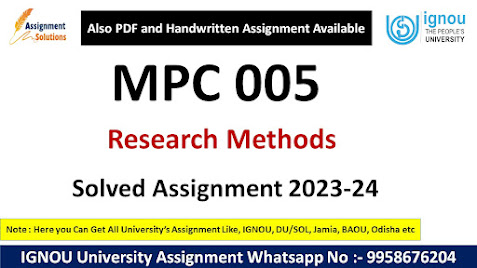MPC 005 Solved Assignment 2023-24
MPC 005 Solved Assignment 2023-24
Research Methods
MPC 005 Solved
Assignment 2023-24 : All assignments are in PDF format which would be send
on email/WhatsApp (9958676204) just after payment.
Course code: MPC 005
Assignment Code: MPC 005/ASST/TMA/2023-24
Marks: 100
There are three
Sections in the Assignment. You have to answer all questions in the Sections.
Assignment A
Answer the following
questions in 1000 words each.
Q1. Define sampling.
Discuss the different methods of sampling.
Sampling refers
to the process of selecting a subset (a sample) from a larger population to
study and draw conclusions about the entire population. Instead of studying the
entire population (which can often be impractical or too costly), researchers
study the sample and make inferences about the larger group from which it was
drawn.
Different Methods of Sampling:
Random Sampling
(or Simple Random Sampling):
Every
individual in the population has an equal chance of being selected in the
sample.
Techniques
include using random number generators or drawing lots.
Example:
Selecting 100 people out of 10,000 using a random number table.
Stratified Sampling:
The population
is divided into subgroups (or strata) based on certain characteristics, and
then a random sample is taken from each subgroup.
This method
ensures that each subgroup is adequately represented.
Example: When
surveying students, ensuring that each grade level is represented by taking
random samples from each grade.
Systematic Sampling:
Every nth
member of the population is selected, starting from a random point.
Example: In a
population of 10,000, every 100th person might be selected for a sample size of
100.
Cluster Sampling:
The population
is divided into clusters (groups), and a random sample of these clusters is
selected. All members within chosen clusters are then surveyed.
It's useful
when the population is spread out geographically.
Example: Selecting
a few schools in a state and surveying all students within those selected
schools.
Quota Sampling (a non-probability method):
The population
is divided into subgroups, and the researcher intentionally sets a number to be
chosen from each subgroup based on certain characteristics.
It's similar to
stratified sampling but doesn't randomly select within subgroups.
Example:
Interviewing 50 males and 50 females from a population.
Convenience Sampling (a non-probability method):
The sample is
chosen based on what's easiest or most convenient for the researcher.
This method is
not very rigorous and may lead to biases.
Example:
Surveying people who walk by a particular location.
Judgmental or
Purposive Sampling (a non-probability method):
The researcher
uses their judgment to select specific individuals or groups that can provide
the required information or fit a specific profile.
Example:
Interviewing experts in a particular field.
Snowball Sampling (a non-probability method):
Used when the
desired sample characteristic is rare or hard-to-reach.
Initial
participants recruit additional participants from their network.
Example:
Researching a specific population like people with a rare disease, where
participants might know others with the same condition.
It's essential
to choose the appropriate sampling method based on the research question, the
nature of the population, and the resources available. The chosen method will
influence the accuracy, reliability, and validity of the results and
conclusions drawn from the research.
Q2. Discuss the steps
involved in research process.
Q3. Discuss the
meaning, types and relevance of qualitative research. Explain the ethical
guidelines in qualitative research.
Assignment B
Answer the following
questions in 400 words each.
Q4. Criteria and misconceptions
of case studies.
Q5. Types of
variables.
Q6. Advantages and
disadvantages of quasi experimental design.
Q7. Types of questions
that can be used in a survey research.
Q8. Types of
correlational research design.
SECTION C
Q9. Difference between
causal comparative and experimental research design
Q10. Types of
hypotheses.
Q11. Types of
Validity.
Q12. Reliability.
Q13. Types of survey
research.
Q14. Quantitative
research design.
Q15. Factorial Design.
Q16. Definition of
research design.
Q17. Field experiment.
Q18. Research Biases.
MPC 005 Solved
Assignment 2023-24 : All assignments are in PDF format which would be send
on email/WhatsApp (9958676204) just after payment.
POST GRADUATE DIPLOMA IN AUDIO PROGRAMME PRODUCTION Master's
Degree Programmes M.A in Psychology (MAPC) ASSIGNMENTS
Dear Learner,
You have to submit one
assignment in each course, i.e. MPC 005 Solved Assignment 2023-24. All these
are Tutor Marked Assignments (TMAs). Before attempting the assignments,
please read the instructions provided in the Programme Guide carefully.
Kindly note, you have
to submit these assignments to the Coordinator of your Study Centre within the
stipulated time for being eligible to appear in the term-end examination. You
must mention your Enrolment Number, Name, Address, Assignment Code and Study
Centre Code on the first page of the assignment. You must obtain a receipt from
the Study Centre for the assignments submitted and retain it. Keep photocopies
of the assignments with you.
Also Check :
MPC 004 Solved Assignment 2023-24
BECC 111 Solved Assignment 2023-24
After evaluation, the
assignments have to be returned to you by the Study Centre. Please insist on
this and keep a record with you. The marks obtained by you will be sent by the
Study Centre to the Student Evaluation Division at IGNOU, New Delhi.
Guidelines for Doing
Assignments
There are five
questions in each assignment, all carry equal marks. Attempt all the questions
in not more than 500 words (each). You will find it useful to keep the
following points in mind:
Planning: Read
the assignments carefully. Go through the units on which they are based, make
some points regarding each question and then rearrange them in a logical order
Organization and
Presentation: Be analytical in your selection of the information for your
answer. Give adequate attention to the introduction and the conclusion. Make
sure that your answer is logical and coherent; has a proper flow of
information.
For IGNOU Solved Assignment PDF & Hand Written
Subscribe YOUTUBE : ASSIGNMENT SOLUTION
WhatsApp Contact : 9958676204


Post a Comment